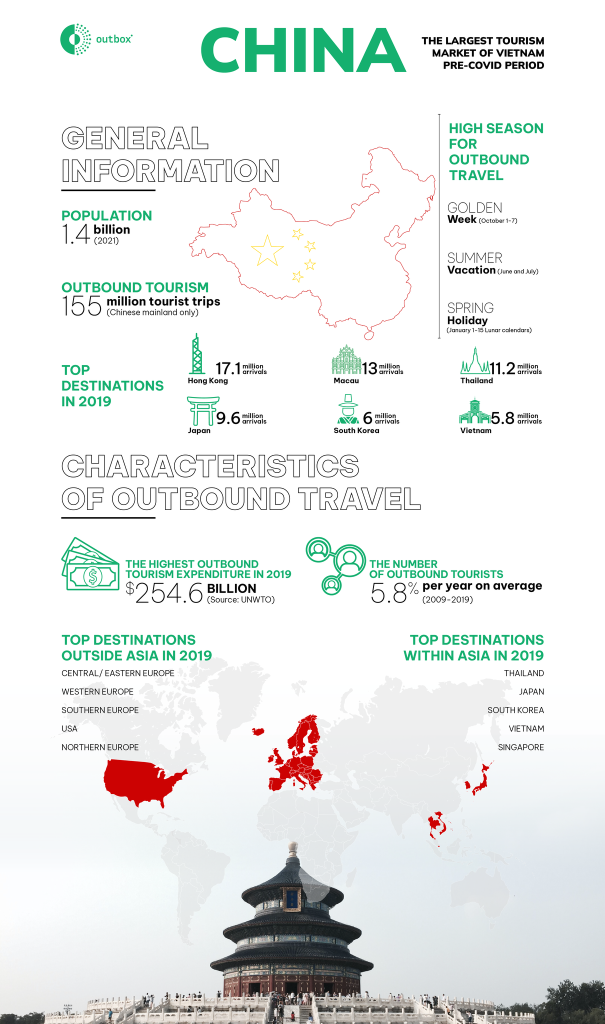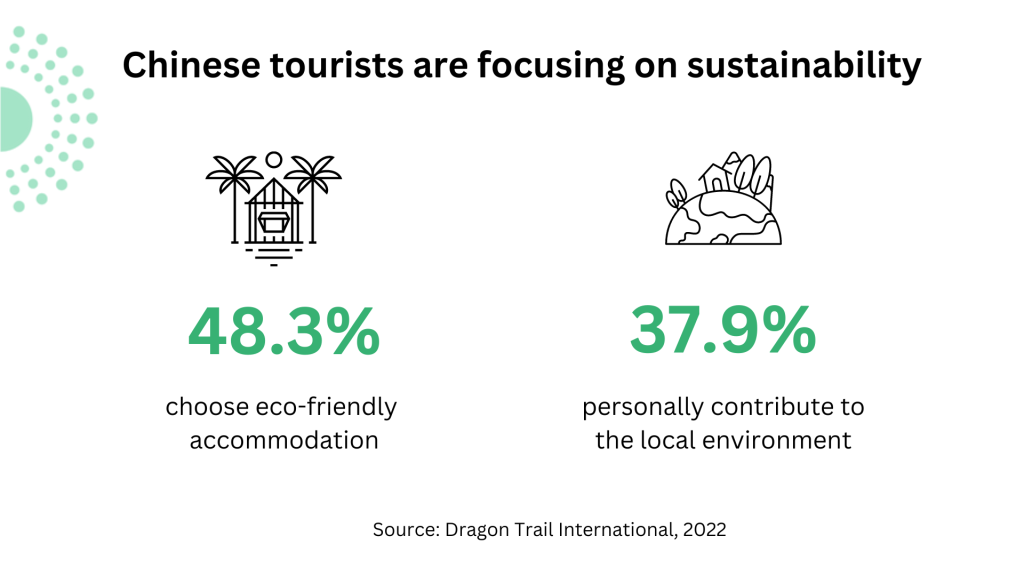In early 2023, China announced it would reopen its borders to foreign tourists for the first time after 3 years of closure to follow the zero-COVID policy. Up to now, China has resumed outbound group tours for Chinese citizens to another 60 countries and destinations.
The reopening of the Chinese tourism market can be considered the most notable highlight in this first quarter of 2023. The tourism industry of many countries around the world, especially in Asia, is expecting the return of the Chinese market creating a significant impact, while the global tourism market is not showing signs of growth as expected.
How have the travel trends in the Chinese tourism market changed? Is the previous approach of Asian destinations still suitable in a different industry after COVID? A prudent data-driven outreach plan is what destinations and businesses need now.
First of all, let’s take a look at the Chinese market in the past and review the initial forecasts about the changing trends of Chinese tourists in the near future for good preparation.
China is the world’s largest tourism market
In 2019, up to 155 million mainland Chinese people traveled abroad. It was 50 million higher than the world’s second-largest outbound tourism market, the United States (99.74 million arrivals). The number of Chinese outbound tourists grew at an average rate of 5.8% per year during the ten-year period from 2009 to 2019, higher than the world average growth of 5.1% per year (UNWTO).
Chinese people not only traveled a lot but also spent the most on outbound trips in the world. According to UNWTO, Chinese tourists spent up to 254.6 billion USD for outbound travel in 2015, accounting for one-fifth of global expenditures.
China’s peak travel seasons are Lunar New Year, summer vacation and Golden Week. The Chinese New Year holiday lasts from 7-15 days, total time off in some places is up to 40 days. Meanwhile, summer vacation takes place in June and July after students have their summer break. The most notable is the Golden Week holiday which lasts continuously for the first 7 days of October. These are very important holidays in China when people often visit their family and travel, especially long-term outbound trips.
Chinese tourists tend to prefer Asian destinations as 90% of Chinese’s outbound trips were to destinations in this region. Top Asian destinations for Chinese tourists are Thailand, Japan, South Korea, and Vietnam. According to the China Tourism Academy (CTA) report, Japan, South Korea and Southeast Asia are top destinations for Chinese travelers. The top three Asian destinations (Thailand, Japan, and South Korea) accounted for more than 50% of the total number of Chinese tourists in the region in 2019.
Outside of Asia, Chinese tourists remain loyal to traditional long-distance destinations such as Europe and North America, with more than 21 million trips made in 2019 to the two regions.

Receiving up to 90% of the total number of Chinese outbound tourists thanks to its advantages in cost and routes, it is easy to see that China is also the largest inbound market for many destinations in Southeast Asia in particular and Asia in general. With China’s top destinations in 2019 including Thailand, Japan, Korea, Vietnam, and Singapore, China dominated the inbound market of these all countries.
In 2019, Thailand welcomed over 40 million international tourists. China ranked first with 11 million arrivals, accounting for a quarter of Thailand’s total inbound visitors. In Singapore and South Korea, China also led with 3.6 and 5.5 million arrivals to the two countries, respectively. For Japan, China also ranked at No. 1 with almost twice as many visitors as South Korea (No.2, 5.5 million visitors). In Vietnam, China was also the largest inbound market with more than 5.8 million visitors, accounting for one-third of the total number of international visitors.
Chinese tourists return but are they still the same?
Southeast Asia and Asia remain top priority of Chinese travelers
According to the latest survey from Trip.com Group regarding destination search trends for Chinese tourists after reopening, the popular destinations they prefer are still Singapore, South Korea, Japan and Thailand. For long-haul destinations, the US, UK and Australia are their favorite destinations.
In another survey by ITB China, up to 76% of the country’s tour operators think that Southeast Asia will be the top destination for Chinese tourists, thanks to the advantages of the sea and high-class resorts.
Basically, the list has not changed much compared to 2019, except for Vietnam. It used to be the fifth largest outbound destination of Chinese tourists in Asia before the pandemic, but was not included in the top 10 of Dragon Trail survey in January 2023.
Countries in the region can keep their hope for the Chinese market once they are ready to return to outbound tourism.
However, there are some opinions that it is still too early to confirm anything about the travel trends or destination choices of Chinese tourists. Although according to China Outbound Tourism Research Institute (COTRI), the Chinese outbound tourism market is forecast to reach two-thirds of 2019, equivalent to 110 million visitors, on the other hand, there are many predictions that 70-80% of Chinese tourists will prioritize domestic trips because of the limitations of aviation recovery compared to 2019.

In fact, since the country reopened in early January, Chinese people have faced shortages of flights and difficulty in booking. These have prevented them from prioritizing outbound travel. According to data from Fliggy, from February 6 to February 12, the number of international flights from China only recovered about 9% compared to the 2019 level. In addition, the issue of Chinese passport renewal or visa policy will also affect the travel trend of this market in the coming times.
Therefore, though it is likely to continue to be the top destination for Chinese tourists in the near future, the competitive pressure between countries in the region will increase a lot compared to 2019. Hopes for a quick return of this market or an even distribution of visitors as before is unlikely this year.
The competitive advantages of countries and destinations will therefore mainly focus on favorable visa policies, direct flight routes and attractive promotions.
Chinese tourists may not travel the way they used to
Before the pandemic, the majority (55%) of Chinese tourists chose to book overseas travel through group tour operators, even as acceptance of independent travel increased (according to Fliggy), but it’s different now. According to Trip.com, Chinese tourists are moving towards small groups with more independent trips. A younger generation of tourists is showing an interest in small group tours, with more flexible arrangements, high-quality services and diverse experiences.
Nature-oriented and outdoor activities are also getting more attention than before. Besides, they are increasingly focusing on sustainability. According to a 2022 Dragon Trail International survey, 48.3% of prospective travelers said they would choose accommodation with environmentally friendly operations, and 37.9% will personally contribute to the local environment by picking up trash or cycling. Moreover, their top reasons to travel overseas were to try local food (60.8%), experience local life (56%) and visit the beach and sea (51.8%).

Destinations should be ready for shifts
The return of the Chinese market is certainly a positive sign for most countries in the region. Southeast Asian countries have many advantages to become the top choice of this market in the next period.
Nevertheless, we should make clear that the return of the Chinese market will also be more challenging and competitive for destinations and businesses. Like other markets, Chinese tourists will certainly be affected by cost sensitivities or fear when returning to outbound travel after more than three years of disconnection from the whole world. Moreover, changes in travel trends and experience needs of “new Chinese tourists” after the pandemic require destinations in the region to have a completely different approach.
Therefore, destinations that want to attract Chinese tourists need to understand the market segments in which they have the most attractive advantages and also the target segments they want to aim for the most. A proper segmentation strategy is a must for destinations and local businesses to have successful marketing and product plans.
Destinations and businesses need to spend more time studying changes in the tourist behavior of their target segments and how to effectively respond to those diverse changes, rather than focus only on simply providing services as before.





